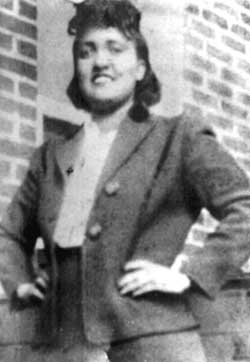Sunday, August 28, 2011
August 28, 2011 : Brooke Greenberg - Eternal Baby
Brooke Greenberg (born January 8, 1993), is an American from Reisterstown, Maryland, who has remained physically and cognitively similar to a toddler, despite her increasing age. She is about 30 inches (76 cm) tall, weighs about 16 pounds (7.3 kg), and has an estimated mental age of nine months to one year. Brooke's doctors have termed her condition Syndrome X.
Brooke was born on January 8, 1993 at Sinai Hospital in Baltimore, Maryland, one month prior to her due date, weighing just four pounds (1.8 kg). She was born with anterior hip dislocation, a condition which caused her legs to be swiveled upwards toward her shoulders; this was corrected surgically. Otherwise, Brooke appeared to be a normal infant.
In her first six years, Brooke Greenberg went through a series of unexplained medical emergencies from which she recovered. She had seven perforated stomach ulcers. She also suffered a seizure. This was followed by what was later diagnosed as a stroke; weeks later, no damage was detected. At age five, Brooke had a mass in her brain that caused her to sleep for 14 days. The doctors diagnosed the mass as a brain tumor. However, Brooke later awoke, and physicians found no tumor present. Brooke's pediatrician, Dr. Lawrence Pakula, states that the source of her sudden illness remains a mystery.
To keep food from getting into her lungs, Brooke is fed through a permanent stomach tube. Feeding her through the tube takes ten hours a day.
In 2006, Richard Walker, PhD in endocrine physiology of the University of South Florida College of Medicine, said that Brooke's body is not developing as a coordinated unit, but as independent parts that are out of sync. She has never been diagnosed with any known genetic disorder or chromosomal abnormality that would help explain why. Her telomeres seem to be shortening at the normal rate.
In 2009, Walker said: "There've been very minimal changes in Brooke's brain ... Various parts of her body, rather than all being at the same stage, seem to be disconnected." Walker noted that Greenberg's brain, for example, is not much more mature than that of a newborn infant. He estimates her mental age at around nine months to a year old. Brooke can make gestures and recognize sounds, but cannot speak. Her bones are like those of a ten-year-old, and she still has her baby teeth, which have an estimated developmental age of about eight years. Said Walker, "We think that Brooke's condition presents us with a unique opportunity to understand the process of aging." "Different parts of her body are developing at different rates, as if they were not a unit but parts of separate organisms," Walker explains.
Dr. Walker believes that the condition resulted from a failure of central control genes. He has identified two more people with similar developmental issues: Gabrielle Williams of Montana (born 2004) and Nicky Freeman of Australia (born 1970), a forty-year-old man who looks like a boy. Others, such as British biologist Aubrey de Grey, believe that aging and development are not related.
Source
Sunday, August 21, 2011
August 21, 2011 : Paris syndrome
Paris syndrome is a transient psychological disorder encountered by Japanese visiting or vacationing in Paris and more generally France and Spain. It is similar in nature to Jerusalem syndrome and Stendhal syndrome.
Japanese visitors are observed to be especially susceptible. It was first noted in Nervure, the French journal of psychiatry in 2004. From the estimated six million yearly visitors, the number of reported cases is significant: according to an administrator at the Japanese embassy in France, around twenty Japanese tourists a year are affected by the syndrome.
The susceptilibity of Japanese people may be linked to the popularity of Paris in Japanese culture, notably the idealized image of Paris prevalent in Japanese advertising, which does not correspond to reality.
Paris Syndrome is characterized by a number of psychiatric symptoms such as acute delusional states, hallucinations, feelings of persecution (perceptions of being a victim of prejudice, aggression, or hostility from others), derealization, depersonalization, anxiety, and also psychosomatic manifestations such as dizziness, tachycardia, sweating, etc.
In fact, the observed clinical picture is quite variable, but it has the characteristic of occurring during trips which confront travellers with things they have not previously experienced and had not anticipated. Principal to the diagnosis is that the experienced symptoms did not exist before the trip and disappear following a return to the sufferer's familiar surroundings. This differs from a 'pathological voyage', in which psychiatric disorders are pre-existing.
Source
Sunday, August 14, 2011
August 14, 2011 : Henrietta Lacks - Immortal Cells
Henrietta Lacks (August 1, 1920 – October 4, 1951) (sometimes erroneously called Helen Lane or Helen Larson) was an African American woman who was the unwitting source of cells from her cancerous tumor, which were cultured by George Otto Gey to create an immortal cell line for medical research. This is now known as the HeLa cell line.
The cells from Henrietta's tumor were given to researcher George Gey, who "discovered that [Henrietta's] cells did something they'd never seen before: They could be kept alive and grow." Before Henrietta, the cells would only survive for a few days. Scientists spent more time trying to keep the cells alive than performing actual research on the cells. Some cells in Lacks's tissue sample behaved differently than others. George Gey was able to isolate one specific cell, multiply it, and start a cell line. Gey named the sample "HeLa," after the initial letters of Henrietta Lacks' name, to protect her identity. As the first human cells that could be grown in a lab were "immortal" (did not die after a few cell divisions), they could then be used for conducting many experiments. This represented an enormous boon to medical and biological research.
As reporter Michael Rogers stated, the growth of HeLa by a researcher at the hospital helped answer the demands of the 10,000 who marched for a cure to polio just shortly before Lacks' death. By 1954, HeLa was being used by Jonas Salk to develop a vaccine for polio. To test Salk's new vaccine, the cells were quickly put into mass production in the first-ever cell production factory.
Demand for the HeLa cells quickly grew. Since they were put into mass production, Henrietta's cells have been mailed to scientists around the globe for "research into cancer, AIDS, the effects of radiation and toxic substances, gene mapping, and countless other scientific pursuits". HeLa cells have been used to test human sensitivity to tape, glue, cosmetics, and many other products. Scientists have grown some 20 tons of her cells.
Doctors still have not discovered the reason for HeLa cells' unique vigor, but suspect that it is due to altered telomerase function. There are almost 11,000 patents involving HeLa cells.
In the early 1970s, the family started getting calls from researchers who wanted blood samples from them to learn the family's genetics (eye colours, hair colours, and genetic connections). The family wondered why and this is when they learned about the removal of Henrietta's cells. No one else in the family had the traits that made her cells unique.
Source
Sunday, August 7, 2011
August 7, 2011 : Phineas Gage - Impalement and Mental Change
Phineas Gage
On September 13, 1848, 25-year-old Gage was foreman of a work gang blasting rock while preparing the roadbed for the Rutland & Burlington Railroad outside the town of Cavendish, Vermont. After a hole was bored into a body of rock, one of Gage's duties was to add blasting powder, a fuse, and sand, then compact the charge into the hole using a large iron rod. Possibly because the sand was omitted, around 4:30 PM:
the powder exploded, carrying an instrument through his head an inch and a fourth in [diameter], and three feet and [seven] inches in length, which he was using at the time. The iron entered on the side of his face...passing back of the left eye, and out at the top of the head
By November 25 Gage was strong enough to return to his parents' home in Lebanon, New Hampshire, where by late December he was "riding out, improving both mentally and physically ." In April 1849 he returned to Cavendish and paid a visit to Harlow, who noted at that time loss of vision (and ptosis) of the left eye, a large scar on the forehead, and "upon the top of the head...a deep depression, two inches by one and one-half inches wide, beneath which the pulsations of the brain can be perceived. Partial paralysis of the left side of the face ." Despite all this, "his physical health is good, and I am inclined to say he has recovered. Has no pain in head, but says it has a queer feeling which he is not able to describe ."
It was not until 1868 that Harlow gave particulars of the mental changes found today (though usually in exaggerated or distorted form – see below) in most presentations of the case. In memorable language, he now described the pre-accident Gage as having been hard-working, responsible, and "a great favorite " with the men in his charge, his employers having regarded him as "the most efficient and capable foreman in their employ." But these same employers, after Gage's accident, "considered the change in his mind so marked that they could not give him his place again ":
The equilibrium or balance, so to speak, between his intellectual faculties and animal propensities, seems to have been destroyed. He is fitful, irreverent, indulging at times in the grossest profanity (which was not previously his custom), manifesting but little deference for his fellows, impatient of restraint or advice when it conflicts with his desires, at times pertinaciously obstinate, yet capricious and vacillating, devising many plans of future operations, which are no sooner arranged than they are abandoned in turn for others appearing more feasible. A child in his intellectual capacity and manifestations, he has the animal passions of a strong man. Previous to his injury, although untrained in the schools, he possessed a well-balanced mind, and was looked upon by those who knew him as a shrewd, smart businessman, very energetic and persistent in executing all his plans of operation. In this regard his mind was radically changed, so decidedly that his friends and acquaintances said he was "no longer Gage ."
Subscribe to:
Comments (Atom)




